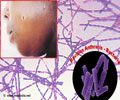It is hard to imagine bacteria as social, communicating creatures, although this has been demonstrated in many studies.

Once the population of quorum-sensing bacteria reaches the millions, it may change from innocuous to pathogenic, or from unhelpful to helpful. The quorum-sensing messages are carried in small molecules that the bacteria release and whose concentration bacteria can measure.
Blocking such a signal can prevent a bacterium from turning, in common language, nasty.
Helen Blackwell, a professor of chemistry at the University of Wisconsin-Madison, has been making artificial compounds that mimic the natural quorum-sensing signals, including some that block a natural signal from binding to its protein target.
In research published today in the journal Chemistry & Biology, Blackwell changed key building blocks in these protein targets one by one. "If that part of the protein is important, the change will have a significant effect on our signal's activity," she explains.
In the study performed with recent graduate students Joseph Gerdt and Christine McInnis, Blackwell expected to knock out, or deactivate, the signals by making these point modifications. Sometimes, however, the changes actually converted an activation signal into a deactivation signal, or vice versa.
Advertisement
Quorum sensing is present in many, but not all, bacteria, and its advantage is clear. A few hundred bacteria cannot hope to overwhelm an animal host, so lying low and evading immune attack is a good survival tactic. But once they number in the millions, they can overwhelm the immune system and reproduce unscathed.
Advertisement
Quorum sensing can also direct soil bacteria that infect soybean roots to harvest nitrogen from the atmosphere and improve crop yields.
Blackwell, who has studied quorum sensing for more than 10 years, explains that inhibiting quorum sensing may provide a new way to control pathogenic bacteria. "We are approaching the end of the antibiotic era, as bacteria evolve resistance to some of our most advanced drugs, and scientists are looking for alternative ways to control bacteria."
While current antibiotics are designed to kill microbes, the goal of quorum sensing would be to keep them "tame" and harmless, Blackwell says. "If these 'on/off' protein modifications are as important as we have found, they may help us design new compounds to inhibit quorum sensing and reduce the harm of bacterial infections, without causing the drug resistance that is producing so many problems today."
Reducing infectivity may allow the immune system to help clear the pathogen, Blackwell says. In procedures such as hip replacement or burn treatment, where infection is common, "this could be used prophylactically, or to augment and extend the lifetime of antibiotics."
The study was performed on Gram-negative bacteria, which are well protected from many drugs by a double membrane. "They also have lots of nasty pumps that eject those drugs that do enter," Blackwell says.
Gram negatives include E. coli, salmonella, shigella, and pseudomonas. Members of the group cause cholera, gonorrhea, meningitis, Legionnaire's disease, and respiratory and gastrointestinal diseases.
Gram negatives "are probably the most challenging infections, and the drugs that we have are really failing," Blackwell says. "But there is also a fascination in seeing how these very simple organisms team up to do things that are impossible in small numbers."
"The compounds and protein modifications we identified in the current study will serve as useful research tools to elucidate, and perhaps redirect, their 'tiny teamwork.'"
Source-Eurekalert












